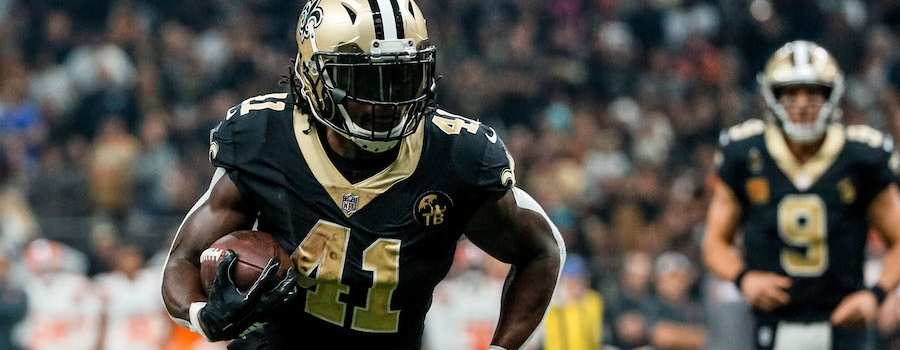The Week 2 NFL main slate kicks off on Sunday, Sept. 15, at 1 p.m. ET. In this piece, I highlight the running backs who stand out in our large suite of analytical DFS Tools, most specifically the industry-leading FantasyLabs Models.
For updates on Vegas spreads and over/unders, check out The Action Network Live Odds page.
Top Running Backs in the FantasyLabs Models
There are four running backs atop the individual Pro Models that Jonathan Bales, Peter Jennings (CSURAM88), Adam Levitan, Sean Koerner, Chris Raybon, Kevin McClelland (SportsGeek) and I have constructed.
- Saquon Barkley: $9,200 DraftKings; $9,200 FanDuel
- Alvin Kamara: $8,200 DraftKings; $8,700 FanDuel
- Mark Ingram: $6,000 DraftKings; $7,500 FanDuel
- Josh Jacobs: $4,700 DraftKings; $6,500 FanDuel
Saquon Barkley: New York Giants (+1.5) vs. Buffalo Bills, 43.5 O/U
Barkley had a relatively disappointing performance last week in a 35-17 road loss to the Cowboys, playing only 79.7% of the Giants’ offensive snaps and garnering just 15 touches.
And yet he still managed 139 scrimmage yards and 15.9 FanDuel points. That just about says it all. Even when Barkley underwhelms, he produces.
While the Giants were probably foolish to use the No. 2 overall pick on Barkley, that shouldn’t be held against him. Of all backs to play at least two games since 2014, Barkley leads the position with his 21.0 FanDuel points per game.
On top of that, no back has exceeded his salary-based expectations more than Barkley has with his +6.01 Plus/Minus.
With his league-high 2,028 scrimmage yards last year, Barkley has a top-three all-time mark among rookie backs, trailing only Eric Dickerson (1983) and Edgerrin James (1999). Given that Barkley was the best running back prospect of the past decade, his success last year wasn’t a surprise.
It’s hard to overstate how good Barkley actually was last year. Even though quarterback Eli Manning was No. 26 with a paltry 5.7 adjusted yards per attempt and the offensive line was No. 29 with 3.90 adjusted line yards per carry (per Football Outsiders), Barkley still produced thanks to his goal-line usage (30 rushes and five targets inside the 10-yard line) and big-play ability (seven touchdowns of 15-plus yards and five of 50-plus yards).
Barkley’s average of 16.0 carries per game is less than ideal, but his receiving workload more than compensates for any rushing shortfall. Last year, he finished No. 2 among all backs with 91 receptions and No. 3 with 121 targets. With those numbers, he broke Reggie Bush’s 2006 rookie record of 88 receptions for a back and tied Bush’s first-year record in targets.
With all the volume Barkley gets as a receiver, he is a true script-independent back. Regardless of whether the Giants win or lose, Saquon is going to get his.
The Bills aren’t an imposing matchup. Last year, they allowed the eighth-most FanDuel points to opposing backfields with 23.9 per game, and last week they allowed 20.2 FanDuel points to the comparable Le’Veon Bell.
It’s worth remembering that Barkley this year doesn’t have the benefit of playing alongside wide receiver Odell Beckham Jr. Since 2017, the Giants have been a much worse team without OBJ.
- Without Beckham (17 games): 16.8 points per game, 1.36 points per drive
- With Beckham (16 games): 21.6 points per game, 1.92 points per drive
The sample is small, but Barkley has been less productive without OBJ, as opposing defenses have been able to focus their attention primarily on him.
- Without Beckham (five games): 17.9 FanDuel points per game, 15.4 carries, 7.2 targets, 4.2 receptions, 122.2 yards and 0.6 touchdowns from scrimmage
- With Beckham (12 games): 22.2 FanDuel points per game, 16.3 carries, 7.6 targets, 6.2 receptions, 129.7 yards and one touchdown from scrimmage
With OBJ gone and his ostensible replacement in Golden Tate suspended to start the year, Barkley is less attractive than he otherwise would be — a sentiment that was apparent in the tournament market last week.
In Week 1, Barkley’s ownership rate decreased as the stakes increased.
- $20 Millionaire Maker: 17.82%
- $333 Wildcat: 13.27%
- $3,000 Luxury Box: 8.58%
In other words, professional daily fantasy players — the sharps — were off Barkley last week.
But this week might be different. The Giants are at home as a small underdog, so Barkley should see close to 90% of the backfield snaps and get as many opportunities as he can handle, especially if wide receiver Sterling Shepard (concussion) is ruled out.
On Sunday morning, I might look to bet the over on Barkey’s reception prop: The Bills allowed the eighth-most targets to running backs last year with 7.8 per game, and last week Bell was targeted nine times (not counting his target on a successful two-point attempt). To find the best bets in the props market, use our Player Props Tool, which is powered by our industry-leading projections. Since last year, the props with a bet quality of 10 have gone 266-129-12, good for a 65% win rate.
A matchup-agnostic three-down back, Barkley leads the slate with his median, ceiling and floor projections and is the No. 1 player at the position in the Levitan Model for FanDuel.
Alvin Kamara: New Orleans Saints (+3) at Los Angeles Rams, 53 Over/Under
Kamara is likely to be popular against the Rams. Last week, in his first game with Mark Ingram no longer on the team, Kamara turned 13 carries and seven receptions on eight targets into 169 yards and 20.4 FanDuel points. Being a lead back suits him.
Of course, Kamara isn’t like most lead backs. He’s never going be a high-volume runner. Not once in his NFL career has Kamara had 20 carries in a game. But Kamara has back-to-back campaigns with at least 100 targets and 80 receptions. Only Hall-of-Famer Marshall Faulk has more seasons in NFL history with 700 yards rushing and 700 yards receiving, and Kamara is in only his third year.
Since entering the league, Kamara has averaged 101.9 scrimmage yards and 0.94 all-purpose touchdowns across his 36 games (including playoffs).
Although Latavius Murray is an Ingram-esque player, in Week 1 he had a sub-Ingram workload with just six rushes and three targets. If Murray maintains that workload going forward, it’s likely that 2019 Kamara will more closely resemble the No. 1 fantasy back we saw last year in Weeks 1-4 than the Ingram-constrained timeshare participant we’ve seen for most of Kamara’s time in New Orleans.
Touchdowns notwithstanding, what Kamara did in Week 1 in terms of usage and yardage is very much in keeping with what he did in the first month of 2018 without Ingram.
- With Murray (2019, Week 1): 13 carries, 8 targets, 7 receptions, 169 scrimmage yards, zero touchdowns
- Without Ingram (2018, Weeks 1-4, four games): 14 carries, 11.8 targets, 8.8 receptions, 152.8 scrimmage yards, 1.5 touchdowns
In his 27 games with Ingram (including playoffs) after Adrian Peterson was traded to the Cardinals in Week 6 of 2017, Kamara averaged 10.7 carries, 5.8 targets, 4.7 receptions, 98.5 scrimmage yards and 0.96 touchdowns.
As long as Latavius doesn’t get an outsized share of the carries inside the five-yard line — neither player had such an attempt in Week 1 — Kamara will get his touchdowns.
It will be important to monitor Murray’s usage in the coming weeks, but right now it looks like Kamara is getting as much work as can reasonably be expected.
Kamara is in a great spot for Week 2.
Three times in his relatively short career he’s faced Wade Phillips’ Rams defense, and he’s had a lot of success.
- 2017, Week 12 (on road): 33.8 FanDuel points, 5-87-1 rushing, 6-101-1 receiving on six targets
- 2018, Week 9 (at home): 31.6 FanDuel points, 19-82-2 rushing, 4-34-1 receiving on five targets
- 2018, Week 20 (at home): 16.6 FanDuel points, 8-15-0 rushing, 11-96-0 receiving on 13 targets
The Rams defense was No. 4 last year with a 90.0 overall grade (per Pro Football Focus), but it was exploitable on the ground, ranking No. 27 with a 1.1% run DVOA. And although the Rams were No. 4 in pass DVOA with a -18.1% mark against running backs, it’s highly doubtful that their linebackers can keep up with Kamara in coverage. Almost no one can — and they were just brutalized last week by Christian McCaffrey, who piled on a 10-81-0 receiving line on 11 targets to go with his 19-128-2 rushing performance.
In fact, no team in Week 1 allowed more fantasy production to opposing backfields than the Rams, who saw 44.0 FanDuel points go to McCaffrey and fullback Alex Armah (one touchdown on one goal-line carry).
In a game with a slate-high 53-point total and facing a vulnerable defense, Kamara is likely to go off.
And that’s to say nothing of the fact that the Saints are in an organizational #RevengeGame against the team that beat them in the NFC Championship. Kamara should Krush.
It’s theoretically not ideal that Kamara is on the road. After all, the Mercedes-Benz Superdome is the Coors Field of fantasy football. But in the post-Peterson era, Kamara has actually been slightly more productive on the road.
- On road (14 games): 19.0 FanDuel points, 112.8 yards and 1.07 touchdowns
- At home (18 games): 18.6 FanDuel points, 103.4 yards and 0.94 touchdowns
That Kamara is on the road should have almost no bearing on how he performs.
I expect Kamara to be incredibly popular this week, given the following facts.
- Kamara has a better matchup and is cheaper than Barkley.
- Ezekiel Elliott saw only 54.4% of the Cowboys’ offensive snaps in Week 1 and is still working his way into game shape.
- McCaffrey plays on Thursday Night Football and is off the slate.
Among the high-priced backs, Kamara will likely command an inordinate share of ownership.
Kamara is tied for No. 1 with 11 Pro Trends on FanDuel, where he’s the top player at the position in the Bales, CSURAM88, Koerner, Raybon, SportsGeek and Freedman Models. He’s also the No. 1 back in the Levitan Model for DraftKings.
Mark Ingram: Baltimore Ravens (-13.5) vs. Arizona Cardinals, 46.5 O/U
Oh, baby.
Before joining the Ravens in the offseason, Ingram had spent the previous half decade as a solidly above-average player for the Saints. Despite always splitting snaps with other backs and being outshined by Kamara in his final seasons in New Orleans, Ingram averaged exactly 1,200 yards and 8.8 touchdowns from scrimmage each year since 2014.
In today’s NFL, that type of production from a running back is not to be ignored.
With the Ravens, Ingram has found a second home.
In quarterback Lamar Jackson’s eight starts last year (including playoffs), the Ravens had a 1940s-esque 61.1% run rate and were efficient on the ground, managing 5.0 yards per carry and sporting a 54% rushing success rate.
That ground-based dominance was apparent in Week 1. While Jackson’s aerial exploits grabbed most of the headlines in the team’s 59-10 win, it’s notable that the Ravens continued to rush the bejeezus out of the ball, amassing 46 carries and a 63.0% run rate. As the lead back, Ingram got in on the action, converting his 14 carries into 107 yards and two touchdowns, good for 25.7 DraftKings points.
He was No. 1 among all backs in Week 1 with 0.91 fantasy points per snap.
Perhaps most importantly, Ingram led all players in Week 1 in touches inside the 10-yard line.
Players with more than one touch inside the 10-yard line in Week One pic.twitter.com/aVfQznlzsa
— Davis Mattek (@DavisMattek) September 11, 2019
And notice that No. 2 running back Gus Edwards got four carries inside the 10 in the blowout. Yes, all of these touches came against a tanking Dolphins team, but the early action suggests that the Ravens will stick with the ground game whenever they can.
While Ingram is certain not to maintain his Week 1 rushing average of 7.6 yards per carry throughout the season, his overall production was not a fluke. For his career, Ingram has an efficient 4.6 yards per carry, and he’s been a steady touchdown producer. A between-the-tackles grinder with sufficient speed and underappreciated agility and vision, Ingram is a good fit with the Ravens, who return all five starters to an offensive line that last year ranked No. 1 with a power run success rate of 78% (per Football Outsiders).
And it helps that this offseason the Ravens promoted run-game aficionado Greg Roman to offensive coordinator: He has a proven knack for getting the best out of aging backs playing next to dual-threat quarterbacks (LeSean McCoy with 2015 Bills, Frank Gore with 2014 49ers). Roman honestly might be the best coordinator Ingram could’ve hoped to find.
We shouldn’t expect 100-yard, two-touchdown games every week, but in an efficient power-based run-heavy offense with a dual-threat quarterback and capable coordinator, Ingram is in an ideal situation.
And this week, 100 yards and two touchdowns is well within the range of outcomes.
Last year, the Cardinals allowed opposing backfields to score 31.5 DraftKings points per game, the second-highest mark in the league. The Lions didn’t have much rushing success last week against the Cardinals, but quarterback Matthew Stafford did go off for 385 yards and three touchdowns, and the Cardinals were generally exploitable, as they allowed 27 points without their top cornerbacks in Patrick Peterson (suspension) and Robert Alford (leg, injured reserve).
2018 Power Run Success Rate
Ravens Offense: 78% (No. 1)
Cardinals Defense: 80% (No. 32)Last year, the Cardinals were the worst team in the league at stopping the kind of runs the Ravens executed better than any other team.
I get why the Ravens are big home favorites.
— Matthew Freedman (@MattFtheOracle) September 12, 2019
The Ravens should be able to put up points.
And Ingram is on the positive side of his home/road and favorite/underdog splits. Since 2014, Ingram has averaged 16.7 DraftKings points with a +2.61 Plus/Minus across his 31 games as a home favorite.
With an elevated floor, Ingram is an option for cash games, especially on DraftKings, where he has an 88% Bargain Rating and position-high nine Pro Trends.
And given how popular Jackson is likely to be, Ingram is an intriguing leverage play for GPPs: If Lamar doesn’t go off, Ingram could be the guy to have a big game against the Cardinals.
Ingram is the No. 1 back in the Freedman Model for DraftKings.
Josh Jacobs: Oakland Raiders (+7.5) vs. Kansas City Chiefs, 53 O/U
In Week 1, Jacobs exploded for 24.3 DraftKings points on the strength of a 23-85-2 rushing and 1-28-0 receiving performance. While he averaged just 3.7 yards per carry and saw only one target, it’s highly encouraging that Jacobs played 74.1% of the Raiders’ snaps and earned 24 of the team’s 27 backfield opportunities.
He finished No. 8 on the week with 0.61 fantasy points per snap, just behind Chris Carson and McCaffrey and just ahead of Marlon Mack and Kamara.
Frankly, none of this is surprising. Jacobs was the No. 1 player in my dynasty rookie rankings this summer, and I highlighted his 2019 upside months ago.
Of all the backs drafted, Jacobs was first last year with a 59.2% positive play rate and second with 38 broken tackles per 100 touches, 2.4 yards per route and 41.9 expected points added (per Sports Info Solutions).
Jacobs has three — maybe four — significant factors in his favor.
The first is that, because he saw limited action at Alabama as a committee back, he should enter the NFL relatively fresh.
The second is he’s young. The backs who play as 21-year-old rookies have historically been significantly more impressive than backs who enter the league at an older age.
And, of course, there’s his draft position. As a first-rounder, he’s likely to see a significant workload because so much was invested into him: In a self-fulfilling mechanism, the Raiders will give him every opportunity to prove himself so that they might be proven correct in drafting him with a premium pick.
And finally, there’s his size. At 220 pounds, Jacobs is built like a lead back. He should be able to withstand the grind of getting 20 touches every week.
Over the past two decades, 11 guys have entered the league as big-bodied first-round 21-year-old backs:
- Saquon Barkley
- Ezekiel Elliott
- Todd Gurley
- Beanie Wells
- Jonathan Stewart
- Marshawn Lynch
- Laurence Maroney
- Steven Jackson
- T.J. Duckett
- Jamal Lewis
- Edgerrin James
Not all of them became stars, but literally every guy in this cohort has had multiple seasons of fantasy utility.
Given how important age, draft position and size are to the running back position, it’s not unreasonable for fantasy players to expect a lot out of Jacobs early on — he could be a top-10 fantasy producer in 2019.
With his breakout performance against a good Broncos defense, Jacobs finished Week 1 in the top 10 at his position. He should already be thought of as a Carson-caliber option.
While Jacobs enjoyed positive game script last week, he almost certainly won’t be afforded that benefit against the Chiefs. Even so, he’s likely to see significant work. Jacobs is a good receiver and could see steady targets if the Raiders fall behind.
And the Chiefs represent a plus matchup. Last year, their defense ranked dead last in rush DVOA with a 9.8% mark, and they allowed the third-most DraftKings points in the league to opposing backfields with 30.9 per game.
Most importantly, Jacobs comes with the Monday Night Football discount: The Raiders opened their season on MNF, which means that Jacobs hadn’t played yet when his Week 2 salaries were set and released on Sunday night. As a result, he’s priced egregiously low for the slate, especially on DraftKings.
As a point of comparison: Jacobs is $200 cheaper than David Montgomery, another rookie who entered the season expected to lead his backfield. But in Week 1, Montgomery had just 45 scoreless scrimmage yards on six carries and a reception.
Because of the MNF discount, Jacobs is the no-doubt must-play cash-game chalk. If you don’t have at least some DFS exposure to Jacobs, you’re probably burning money.
Jacobs is the No. 1 running back in the Bales, CSURAM88, Koerner, Raybon & SportsGeek Models for DraftKings, where he has an immodest +5.30 Projected Plus/Minus.

Pictured: Minnesota Vikings running back Dalvin Cook (33). Photo credit: Brace Hemmelgarn-USA TODAY Sports.
Upside Running Backs for Guaranteed Prize Pools
Dalvin Cook, Minnesota Vikings ($7,200 DK, $7,900 FD): Cook looked explosive and agile in Week 1 on his way to 120 yards and two touchdowns, and the Vikings indicated that they are fully committed to their ground game, racking up 38 team carries to just 10 pass attempts.
David Johnson, Arizona Cardinals ($7,100 DK, $7,300 FD): Johnson put up 137 yards and a touchdown in Week 1, and he specifically got his groove back as a receiver, lining up out wide or in the slot for 16 snaps and leading all backs with 45 air yards.
Todd Gurley, Los Angeles Rams ($7,000 DK, $7,000 FD): Gurley underwhelmed last week with just 15 touches and 70.1% of the offensive snaps, and he lost out on a pair of goal-line touchdowns that went to Malcolm Brown, but he has a position-high 11 Pro Trends on FanDuel, and he’s still the lead back on an explosive offense in a game with the highest total on the slate.
James Conner, Pittsburgh Steelers ($6,800 DK, $7,700 FD): Conner farted his way to 65 yards on 10 carries and four targets in Week 1, but the Steelers are -4 favorites in Pittsburgh for Week 2, and last year Conner averaged 22.4 DraftKings points with a +4.93 Plus/Minus across seven games as a home favorite.
Chris Carson, Seattle Seahawks ($6,400 DK, $7,400 FD): Carson managed just 81 yards last week, but he scored two touchdowns, got all three of the Seahawks’ touches within the 10-yard line and led the team with 15 carries and six receptions.
Leonard Fournette, Jacksonville Jaguars ($6,300 DK, $6,900 FD): Fournette is stuck with sixth-round second-string rookie quarterback Gardner Minshew, so the Jags offense might be less imposing than it otherwise would be, but Lenny played 86.2% of the snaps in Week 1 and has a position-high +3.78 Projected Plus/Minus on FanDuel, and the Texans just allowed 32.1 FanDuel points to the Saints backfield.
Austin Ekeler, Los Angeles Chargers ($6,100 DK, $7,500 FD): Danny Woodhead 2.0 crushed in Week 1 with 154 yards and three touchdowns starting in the place of Melvin Gordon (holdout), and Ekeler has averaged 18.6 DraftKings points, 86.2 yards and 0.91 touchdowns across his 11 career games with 10-plus touches.
Marlon Mack, Indianapolis Colts ($5,900 DK, $7,400 FD): Mack benefited from the Colts’ 61.1% run rate, putting up 174 yards and a touchdown on a league-high 25 carries, and last year he averaged 18.4 DraftKings points, 93.5 yards and one touchdown in two games against the Titans.
Giovani Bernard, Cincinnati Bengals ($5,300 DK, $5,700 FD): Bernard is slated to see a full workload if starter Joe Mixon (ankle) is unable to play, and in his two games last year without Mixon he averaged 20.4 DraftKings points and a +10.68 Plus/Minus on the strength of 13.5 carries and 6.5 targets, and the 49ers were No. 26 with a PFF run-defense grade of 75.2 in 2018.
Matt Breida, San Francisco 49ers ($5,200 DK, $5,600 FD): Breida is now the lead back with Tevin Coleman (ankle) out for the next few weeks, and he has averaged 16.0 DraftKings points, 96.7 yards and 0.29 touchdowns across his seven games with at least 15 combined carries and targets.
Devin Singletary, Buffalo Bills ($4,200 DK, $5,700 FD): Singletary played 69.6% of the Bills’ offensive snaps last week, and he made the most of his opportunities, scoring 14.8 DraftKings points on nine touches and setting himself up for a Week 2 usage increase.
Malcolm Brown, Los Angeles Rams ($4,100 DK, $5,500 FD): Brown played on just 21 snaps in Week 1, but he impressed with his 11-53-2 rushing performance, and he could see a major boost in volume if he steals more snaps from the caution-ensconced Gurley.
Chris Thompson, Washington Redskins ($3,900 DK, $5,300 FD): Thompson played on 64.2% of the Redskins’ offensive snaps last week, he could see even more playing time this week with Derrius Guice (knee) expected to sit, last year the Cowboys ranked No. 26 with a 12.5% pass DVOA against running backs and since his 2017 breakout, Thompson has averaged 15.1 DraftKings points per game at home.
Adrian Peterson, Washington Redskins ($3,400 DK, $4,800 FD): Peterson’s salary was set before Guice’s knee injury was made public, so he is available at a discount as the presumptive Week 2 starter and could offer massive value if the Redskins find a way to win, given that last year he averaged 22.5 DraftKings points in the four games the team won by at least seven points.
FantasyLabs Positional Breakdowns
For more in-depth NFL analysis information, check out The Action Network.
Matthew Freedman is the Editor-in-Chief of FantasyLabs. He has a dog and sometimes a British accent. In Cedar Rapids, Iowa, he’s known only as The Labyrinthian.
Pictured above: Josh Jacobs
Photo credit: Mark J. Rebilas-USA TODAY Sports





